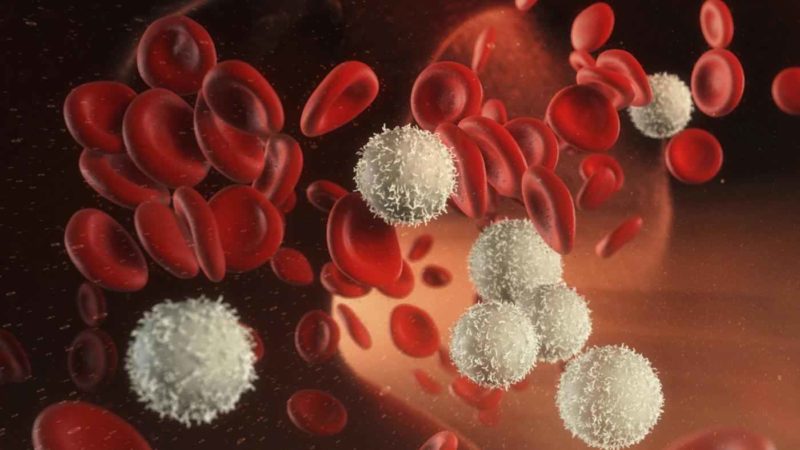The main purpose of a woman given to her by nature is the bearing of a human baby. In this regard, their protective and adaptive functions are much more developed than those of the strong half. White blood cells are responsible for the state of the body's immune system, but it should be borne in mind that not always exceeding their norm in the blood in women indicates pathology.
Material Content:
White blood cell counts for women of different ages
White blood cells are the largest of all blood cells, which allows them to be clearly seen by microscopic examination. They are divided into species, depending on their coloring elements and the shape of the core.

In the blood of any adult, the leukocyte composition is as follows:
- neutrophils make up from 40 to 75%, with a purple and violet hue;
- blue and white lymphocytes - from 20 to 45;
- bluish-gray monocytes - from 3 to 8;
- orange-pink eosinophils - a maximum of 5%;
- and blue-violet basophils - 1.
The first substance destroys harmful particles that enter the body. The second alerts about the danger, forms antibodies and transmits the accumulated information to the offspring in the first hours after birth during the first breastfeeding.
Leukocyte analysis can show various disorders:
- Increased white blood cell count (leukocytosis).
- Low rates - leukopenia.
- The broken structure of the formula.
- Underdevelopment of cells.
In certain periods of a woman’s life, the number of blood cells can be far from normal, but do not talk about the disease. This happens, for example, during pregnancy.
Here are the white blood cell counts for women of different ages:
| Age | White blood cell count (* 109) |
|---|---|
| Girls and girls under 16 years old | from 4.5 to 12.5 |
| Girls under 20 years old | 4.2 to 10.5 |
| Girls and women 21 years old, 30.40.50.60 years | 3.98 to 10.4 |
| Pregnancy | Up to 15 |
These figures indicate that you should not panic when deviations from the norm - each individual case should be considered individually.
When the white blood cell count is increased
The inconsistency of the test results depends on many factors, for example, the quality and quantity of the products used, the mental and emotional state, as well as:
- how much you do physical education or sports;
- season and time of day;
- climate change;
- medications taken;
- period before menstruation.
The temperature of the water when you take a bath also affects the amount of these elements.

Elevated leukocytes in the blood (denoted by WBC) during decoding can show the following conditions:
- Angina, bronchitis, tracheitis, pharyngitis and other acute inflammatory processes.
- Menstruation.
- Overtraining.
- Bleeding, especially severe and prolonged.
- Myocardial infarction and stroke.
- Long exposure to the scorching sun or burns.
- Subcooling or overheating in a hot bath.
- Inflammatory processes of the gynecological sphere.
- Appendicitis or meningitis.
- Renal failure in acute form.
Doctors share the problems associated with an increased level of white blood cells in the body, physiological and pathological. In the first case, unpredictable situations take place, due to which the level of leukocytes increases in a healthy person. The second will indicate the development of pathological processes in the body.
When white blood cell counts are underestimated
You can talk about lowered white blood cells in the blood if this indicator drops below 4 * 109 / l, which indicates a breakdown of the immune system and other factors:
- disturbances in the brain, which are affected by injuries and internal defects;
- insufficient amounts of vitamins B1 and 12 in the body and copper with iron;
- when white blood cells are destroyed in an increased mode due to the use of potent drugs - antibacterial, against cancer or epileptic seizures;
- viral infections, as well as measles, rubella, hepatitis or HIV;
- prolonged depression, or severe exhaustion of the body;
- radiation sickness and the 1st stage of leukemia.

Hereditary predisposition also affects the level of white blood cells in a woman’s blood.
Important: when deciphering test results, always tell your doctor about the medications you are taking.
Another reason when the number of blood cells is reduced is autoimmune ailments.
White blood cells and pregnancy
As a rule, pregnancy “causes” blood cells to increase in number. This is explained by increased protection of the body in this important period of a woman's life. This process does not stop during childbirth, as well as breastfeeding the baby.
But this increase should begin only from the 2nd trimester, and before that, from 3 to 9 * 109 / l can be considered the norm.
From 5 months of gestation, the number of leukocytes reaches 15 * 109 / l. Although in this case, additional tests are taken to exclude the onset of the development of a serious ailment.

An increase in white blood cells can mean the presence of an inflammatory process, and not only:
- Urinary problems.
- Getting injured and bleeding.
- Allergic reaction.
- Peritonitis.
- The various types of neoplasms in organs.
It happens that white blood cells become less in a pregnant woman, which is explained by the appearance of certain diseases. This can be influenza, measles, hepatitis, rubella, colitis, gastritis, kidney failure, or endocrine disruption.
When a white blood cell test is prescribed
The primary indication for testing for white blood cells in a woman's blood is a suspicion of the presence of an infectious disease or inflammation, which is in a hidden state.
A malignant bone marrow tumor "makes" the level of leukocytes go off scale. It is also necessary to control their quantity during radiation therapy in order to evaluate how effective the treatment is.

Doctors also prescribe blood tests for such ailments as:
- infection of the body with parasites;
- allergic reactions.
In case of any health problem, it is advisable to have a general blood test performed in any medical institution (clinic or hospital).
How to prepare for a white blood cell test
To obtain the most reliable testimony of the analysis, certain rules will be required. This is explained by the fact that the results may be different due to some conditions.

Therefore, follow the recommendations before donating blood, regardless of the type - from the finger (capillary) or vein (venous):
- You can’t have breakfast - the maximum that you can afford is to drink plain water. Although there is no data on the distortion of the results after a person drinks a cup of tea with sugar.
- The day before the study, you will need to take a break in training if you are used to taking time out with regular physical activity.
- Try not to have strong emotional feelings a couple of hours before taking the tests.
- The day before the examination, avoid the following diagnostic procedures - ultrasound, MRI, CT or X-ray.
The most reliable way is taking blood from a vein. This is explained by the fact that during the pressure exerted on the finger to take fluid from the body, a leukocyte discharge is possible, which will distort the result.
As you can see, the level of leukocytes can say a lot about the state of health of a woman, so you should not delay the delivery of tests if there are any pathological symptoms. Thus, you will protect yourself from the development of serious diseases and at the initial stage stop the disease. Health to you and your loved ones!












